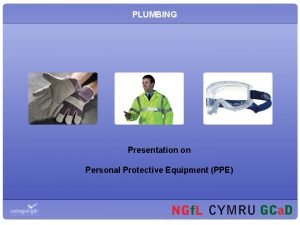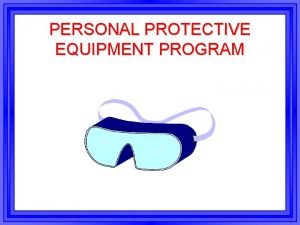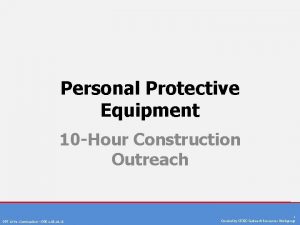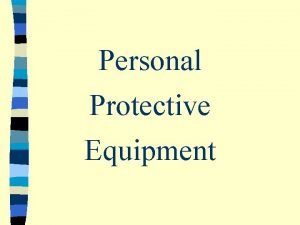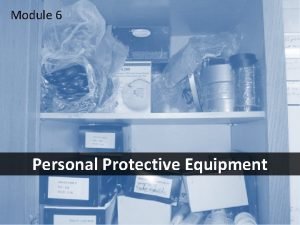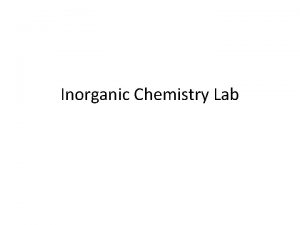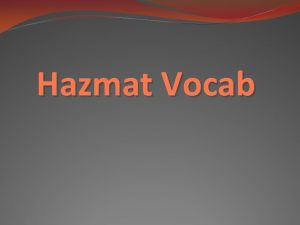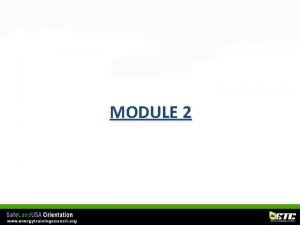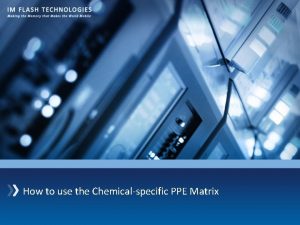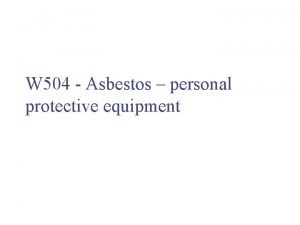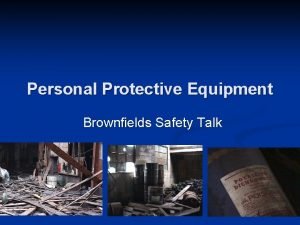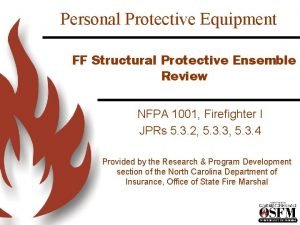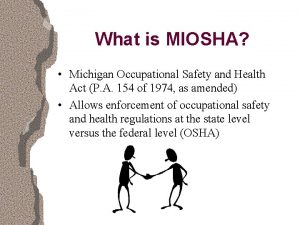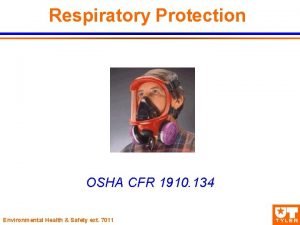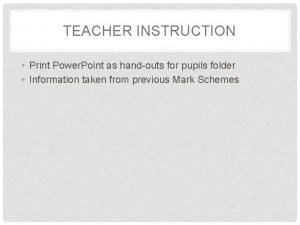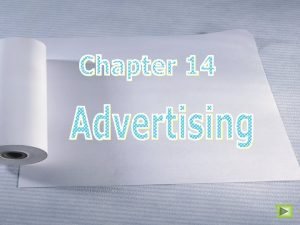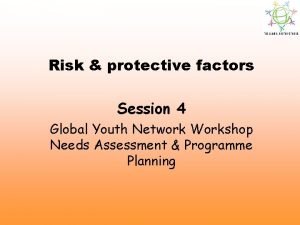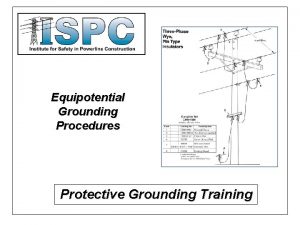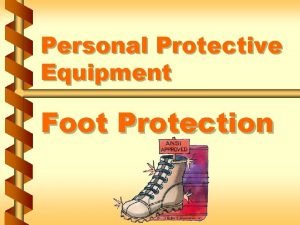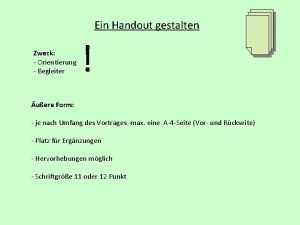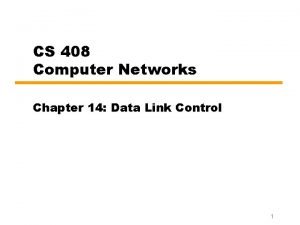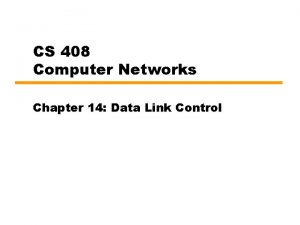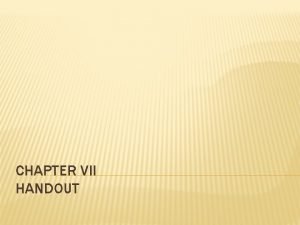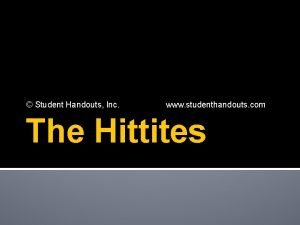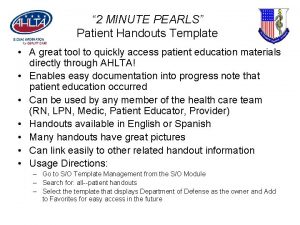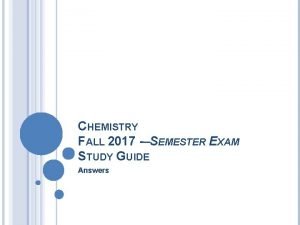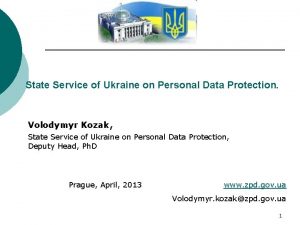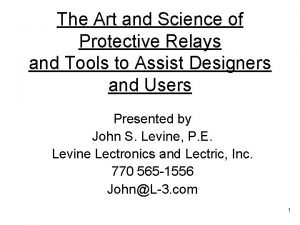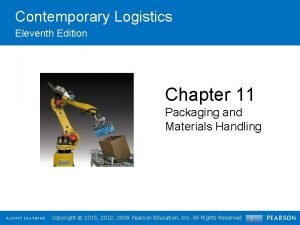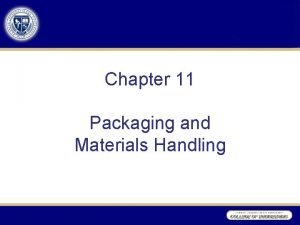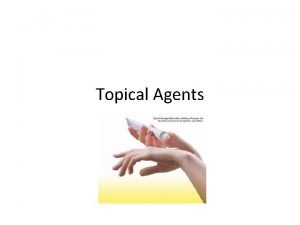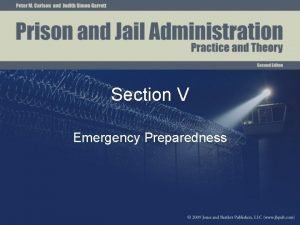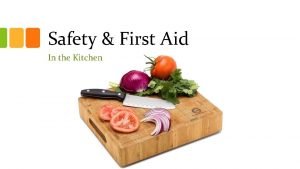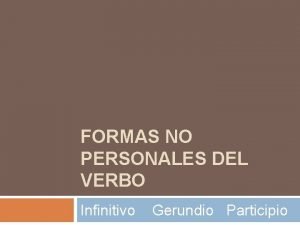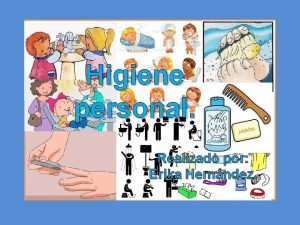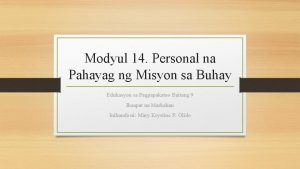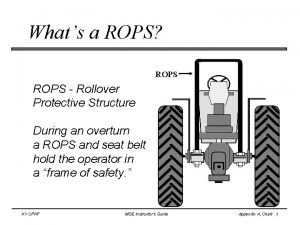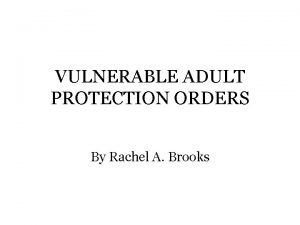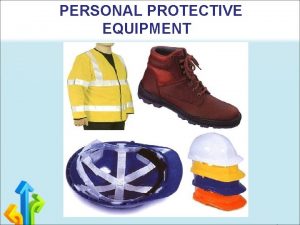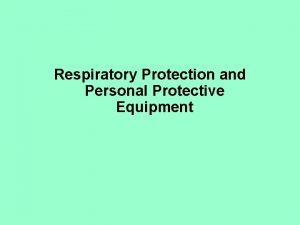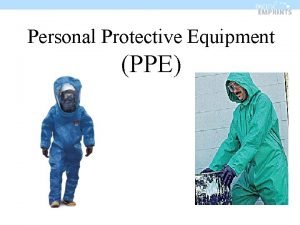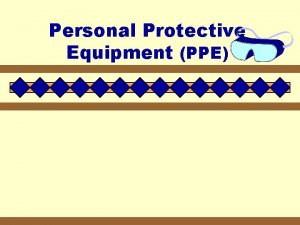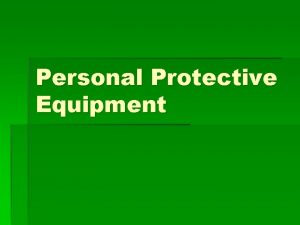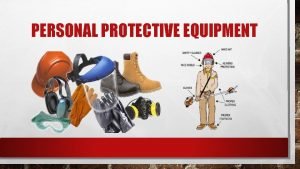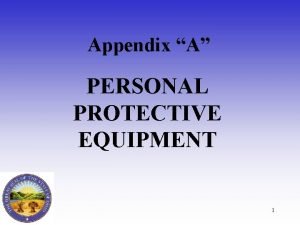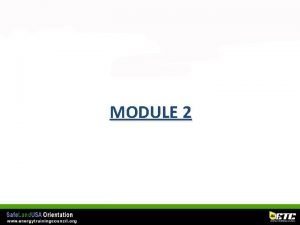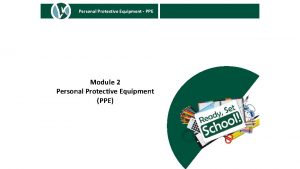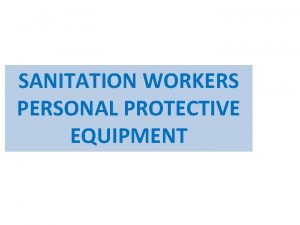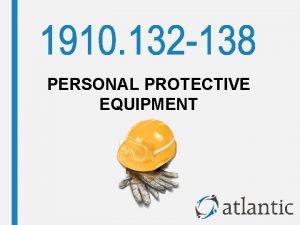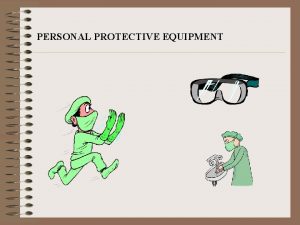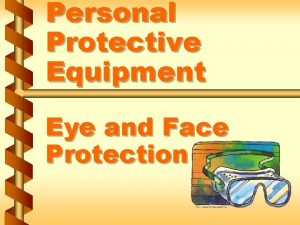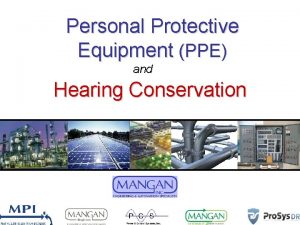Respiratory Protection and Personal Protective Equipment Handouts in



















































- Slides: 51

Respiratory Protection and Personal Protective Equipment

Handouts in binders • List of terms to know • Copy of overhead slides • Personal Protective Equipment: Respirators and gloves, Mark Nicas • NIOSH Respirator Decision Logic Sequence • Assigned protection factors (NIOSH) • Protective Clothing and Equipment • 3 M Summary of ANSI Z 88. 2 -1992 in 3 M Job Health Highlights, Fall 1993. • NIOSH guide: Particulate Respirators 42 CFR 84

Recommended reading • “White Book”, 1997, AIHA, Chapters 35 & 36 • Guide to Industrial Respirator Protection, NIOSH, 1987 “Blue Book” • Quick Selection Guide to Chemical Protective Clothing, Krister Forsberg and Zack Mansdorf, Van Nostrand Reinhold, New York, 1989 • Commodity Specification for Air, Arlington, VA; Compressed Gas Assoc. , 1989 • ANSI Standard for Respiratory Protection, Z 88. 2 -1992, American National Standards Institute, Inc. • NIOSH Pocket Guide to Chemical Hazards, “Green book”, July 97 • CFR 1910. 134, Feb 8, ‘ 98 • Respiratory Protection: A Manual and Guideline, AIHA

OSHA’s Respiratory Protection Program 1. Written program 2. Selection base on hazards involved 3. Operator training 4. Reserved (? ) 5. Cleaning and disinfection of respirators 6. Storage of respirators 7. Inspection and maintenance of respirators 8. Surveillance of worker exposures 9. Regular evaluation of respirator program 10. Medical evaluation of respirator users 11. Use of approved respirators

Respiratory protection OSHA’s general policy on respirator use: • Where engineering or administrative controls are not feasible or insufficient • During the time when engineering or administrative controls are being implemented • For emergency response situations

Recent changes in regulations • NIOSH changes to respirator equipment approvals • Substance specific standards sometimes contain unique requirements • Federal OSHA issued new 1910. 134 standard in February 98 – – – Consolidates other standards’ requirements APF deferred Some changes in medical qualifications Fit testing required for all tight-fitting respirators Cartridge changeout to be based on objective data Respirator administrator

Determining physical state of airborne contaminant Listing of contaminant in TLV book is a clue but there are some exceptions Guidelines for estimating airborne phase have been developed based on: • identity of the major constituents • saturated vapor concentrations of constituents • estimate of total airborne mass concentration (the saturated vapor concentration and total airborne concentration can help predict phase)

Types of respirators Air-purifying respirators – – Filters (for particulates) Cartridges (for gases or vapors) - may have filters, too Canisters (used with “gas masks” -- large capacity) Oxygen must be > 19. 5% • Atmosphere supplying respirators – SCBA’s – Supplied air respirators (Type C or CE) – Combinations of SCBA’s and SAR’s

Aerosol removing respirators Filters can remove dusts, mists, fumes, others Cannot protect against gases, vapors, or low O 2 Removal mechanisms: • interception • sedimentation • impaction • diffusion • electrostatic attraction

New NIOSH 42 CFR 84 Regulations • Effective July 1995 • For testing, certifying non-powered, airpurifying, particulate-filter respirators • Replaces DM and DFM, spray paint, pesticide, etc. cartridges • Does not change chemical cartridge, SCBA, airline, gas mask, PAPR types • Manufacturers can ship and sell Part 11 filter cartridges until July 1998

Nine filter types • 3 levels of filter efficiency: – 95% (called “ 95”) – 99% (called “ 99”) – 99. 97% (called “ 100”) • 3 categories of resistance to filter efficiency degradation: –N (Not resistant to oil) –R (Resistant to oil) –P (oil Proof)

Selection of N, R, and P-series filters • If no oil particles are present in the work environment, use a filter of any series. • If oil particles are present, use an R- or Pseries filter. • If oil particles are present and the filter is to be used for more than one work shift, use only a P-series filter. • Selection of filter efficiency depends on how much filter leakage can be accepted. • Choice of facepiece depends on level of protection needed (APF).

Gas and vapor removing respirators Use sorbents Housed in cartridges or canisters Removal mechanisms: – – adsorption absorption chemisorption catalysis Designed for specific contaminants or classes

Gas and vapor removing cartridges Organic vapor cartridges: • currently tested with CCl 4 at 1000 ppm (only) • may or may not be very effective for specific vapors • seek guidance from respirator manufacturer including test data on vapor in use • only small amount of charcoal in cartridges • more charcoal in canisters • color code: black

Service life of cartridges or canisters Depends on: • quality and amount of sorbent • packing uniformity and density • exposure conditions, breathing rate • relative humidity • temperature • contaminant concentration • affinity of the gas or vapor for the sorbent • presence of other gases and vapors

Acid gas respirators • Designed for removing acidic gases • Tested by NIOSH against chlorine, HCl and SO 2 (only) • Limited to fairly low concentrations – Chlorine – Hydrogen chloride – Sulfur dioxide • Color code: white 10 ppm 50 ppm

Alkaline gas cartridges • Contains chemicals for removing alkaline gases such as: – ammonia – methylamine • Concentrations limited – ammonia – methylamine 300 ppm 100 ppm • Color code: green

Air-purifying respirators additional information • Replace cartridges: – NIOSH: daily or after each use, or even more often if odor, taste, or irritation – some canisters may have end of service life indicators • Other cartridges available: – – – – – pesticides carbon monoxide ethylene oxide formaldehyde hydrogen fluoride hydrogen sulfide mercury phosphine vinyl chloride

Colors for AP elements • • • Acid gas Organic vapors Ammonia gas Carbon monoxide Acid gases and organic vapors Acid gas, ammonia, and OV Acid gas, ammonia, CO, and OV Other vapors and gases Radioactive materials (HEPA) Dusts, fumes, mists (non-radio) white black green blue yellow brown red olive purple * orange *

“Adequate warning properties” NIOSH permits air purifying respirators only if the contaminant has adequate warning properties: – reliable detection of the contaminant below the PEL by user’s sense of smell, taste, or irritation – only applies to gases and vapors -- not particulate – Exception is if AP element has an ESLI. – Remember that odor thresholds vary substantially from one individual to another OSHA: respirator cartridge changeout based on odors or taste unacceptable (new standard)

NIOSH/MSHA certification • Testing and certification codes issued (TC #) • NIOSH personnel do actual testing • List of approved respirators published • • • TC 13 F + 2 -3 digits TC 14 G + 2 -3 digits TC 19 C + 2 -3 digits TC 21 C + 2 -3 digits TC 23 C + 2 -3 digits SCBA AP gas mask SAR Particulate AP Gas or vapor AP

Atmosphere-supplying respirators • Air-line respirators • Self-contained breathing apparatus (SCBA) • Combination SCBA and SAR Must be supplied with Grade D breathing air, usually from bottles or compressors

Supplied air respirators • Airline respirators – called “Type C” or “Type CE” – hose can be up to 300 feet – 4 cfm required for tight-fitting mask, 6 cfm for hoods and helmets – available in demand, pressure demand, and continuous flow arrangements • Hose masks – Type A (motor or hand-operated blower) – Type B (no blower) – large diameter hoses

Sources of breathing air • Compressors – – – Subject to failure If oil-lubricated, can overheat changing oil mist into CO Carbon vane type are available and oil-less Can run continuously Can be fitted with CO sensor and/or adsorption units Air intake location is critical • Compressed gas cylinders (breathing air) – Can be up to 3500 psi – Finite air supply. . . for limited time spans – Do not rely on utility services • Blowers used for hose masks

Criteria for Grade D compressed air • Oxygen 19. 5% to 23. 5% oxygen (vol) • Hydrocarbons < 5 mg/M 3 (oil mist) • Carbon dioxide < 1000 ppm • Carbon monoxide < 10 ppm • Odor no pronounced odor

Self-contained breathing apparatus • Open-circuit type – – – bottled air from 2000 to 4500 psi typically time from 15 min to 60 min typically demand or pressure demand or continuous flow can be combined with supplied air respirator escape-only type available in 5, 7, 10 or 15 minute size • Closed-circuit type (also called re-breathers) – – – could be either negative or positive pressure type possible to “over breathe” more complicated to maintain requires more training longer use period. . . sometimes up to 4 hours

Respirator selection Routine use vs non-routine use Workplace hazards Physical Characteristics Physical demands of the work Respirator capabilities and limitations

Exposure assessments • Identify airborne contaminants where possible • Match up specifications and limitations of respirators • Consider abnormal conditions that may cause concentrations to rise • Think in terms of “worst case” exposures • Apply substance-specific requirements • Communicate information to employees; discuss signs, symptoms of overexposure • Keep good records

Respirator capabilities, limitations Protection factors • protection factor: pf = Co/Ci • Assigned protection factor APF (also called hazard ratio) • Penetration: • Fit factor is the PF observed during a quantitative fit test (usually only 5 to 10 min) • Workplace protection factor (WPF) – time up to 8 hours – the Ci value is the average contaminant value inside the respirator

Protection factors, continued • Effective protection factor – over unspecified length of time – supposed to represent total protection afforded worker including times worn and not worn. – Used in OSHA’s lead standard • Program protection factor – sometimes used with lead aerosols • Assigned protection factor – NIOSH: minimum anticipated WPF provided by a properly functioning respirator or class of respirators

Protection factors, continued • Maximum use concentration (MUC) – the product of the APF and the exposure limit – must not be > IDLH or in excess of the cartridge limits – Based on several factors: APF, IDLH concentrations, and regulatory limits

Fit testing • Qualitative fit testing (QLFTs) – – – isoamyl acetate (IAA) irritant smoke (usually titanium and stannic chloride) saccharin aerosol (taste test) denatonium benzoate (Bitrex) must verify wearer can respond wearer must be truthful • Quantitative fit testing (QNFTs) – – – dioctyl phthalate aerosol (DOP) corn oil sodium chloride DEHS ambient air (with submicron particulate counting) ambient air (pressure differential)

Non-routine use of respirators Three situations require careful consideration: • entry into confined spaces • entry into oxygen-deficient atmospheres • emergencies IDLH ANSI: “. . . any atmosphere that poses an immediate, irreversible debilitating effects on health. . . ” (acute effects vs chronic exposures) New OSHA standard requires atmospheres to be considered IDLH unless shown otherwise

IDLH, continued NIOSH: IDLH based on two factors: • worker must be able to escape within 30 min without losing life or suffering permanent health damage, and • worker must be able to escape without severe eye or respiratory irritation or other reactions that could inhibit escape also, atmospheres > LEL are IDLH

NIOSH respirator decision logic IDLH atmospheres -- Only 2 types allowed: – SCBA in pressure-demand mode (>15 minute air supply) – Type C airline respirator, pressure-demand or continuous flow mode, with auxiliary escape bottle (minimum service life of 3 minutes) IDLH atmospheres (low oxygen) – Can use demand (negative pressure) airline respirator

Respirator standards Respirator testing, approval standards: 42 CFR 84 (NIOSH), formerly NIOSH/MSHA Respirator use standards: • OSHA - 29 CFR 1910. 134 (and others) • ANSI Z 88. 2 - 1992 • MSHA • NRC

Hearing protection • Above 120 d. BA conduction of noise to the inner ear starts to defeat plugs, muffs, etc. • Types of protection devices: – – – special helmets ear muffs and cups ear plugs (aural and superaural) fitting by medical people is advisable superaural “caps” held in place by bands - less effective • Combination muffs and plugs • Above 1000 Hz - little difference between type

Dermal hazard categories • Chemical, e. g. , irritants, allergens corrosives, dermal toxins systemic toxins, cancer causing agents • Physical, e. g. , trauma producing, thermal hazards (hot/cold), fire, vibration, radiation • Biological, e. g. , human, animal, or environmental pathogens

Gloves and protective clothing factors to consider • Degradation – harmful change in one or more physical properties of a protective material when subjected to a chemical • Penetration – the flow of chemicals through closures, zippers, seams, pinholes, etc. • Permeation – movement of a chemical through a protective material

Factors to consider (continued) • Permeation rate – the amount (mass) of chemical per unit time for an area of material once steady state has been achieved. Units are usually expressed as mg of chemical per square meter of material per minute (or second). – Permeation tests are usually conducted for up to 8 hours. If no breakthrough, usually expressed as BT> 480 min. • Breakthrough time – time for a chemical to pass through a protective material

3 Steps for material testing • Sorption of the chemical on the surface • Diffusion of the chemical through the material • Desorption of the chemical from the material’s inside surface Challenge and collection chambers used – Collection chamber is swept with a gas or liquid to present the chemical to a sensitive analytical instrument.

Glove selection • • Chemical toxicity Permeation parameters for chemical/glove Nature of exposure Physical factors associated with job – cut resistance and tearing – manual dexterity and flexibility – temperature extremes • Cost

Chemical protective clothing analysis • • Job classification or task Process or task summary Potential or actual chemical hazards Physical properties of chemicals Potential or actual physical hazards Chemical contact periods Type of potential contact Body zones of potential contact

PPE regulations OSHA (29 CFR. 1910. 132) requires: • hazard assessments before worker assignment • selection of appropriate equipment • communicate selection decision to employees • train in use and limitations of PPE • employer to supply PPE

OSHA’s 8 -step PPE process 1. Determine type of hazard(s) like to occur 2. Determine adverse effects of unprotected exposures 3. See if other control options can be used 4. Determine performance characteristics needed for protection 5. Determine need for decontamination 6. Determine ergonomic constraints presented 7. Determine cost of various options 8. Make the selection

New OSHA Respirator Standard • Use engineering controls where feasible • Employer supplies respirators and establishes a program • Program must be written with work-site specific procedures and elements for required respirator use • Program must have an administrator • Medical evaluations • Fit testing for tight-fitting respirators

New OSHA Respirator Standard • New procedures where respirator is worn voluntarily • Appropriate selection of respirators - NIOSH certification and within certification limits • Evaluate exposures - assume IDLH if unable to evaluate • Selection to include sufficient number…to get a good fit • Change-out of cartridges - ESLI or “objective data”

New OSHA Respirator Standard Medical evaluations: • PLHCP • Screening questionnaire • Follow-up examination if any positive answers • Supply PLHCP with respirator info, work conditions, other PPE, duration and frequency or respirator use, copy of written program and OSHA standard • Must supply PAPR if negative pressure respirator is unacceptable

New OSHA Respirator Standard Additional Medical evaluations required when: • Report of related medical signs or symptoms • PLHCP, supervisor or program administrator informs the employer that a reevaluation is needed • Information from program, fit-testing suggest need for reevaluation • Change in workplace increases physiological burden on worker

New OSHA Respirator Standard Fit testing: • Qualitative or quantitative methods used for tight-fitting respirators • Must be re-fitted when respirator changed annually • Qualitative can only be used with fit factors of 100 or less; quantitative required when FF > 100 • Must use methods in Appendix A • Atmosphere-supplying respirator must be tested when in negative pressure mode

New OSHA Respirator Standard Other things … • No facial hair that can interfere with seal • User seal test • Cannot base cartridge change-outs on odor, smell or taste • Seal check whenever donning respirator • In IDLH areas, must have standby outside equipped and trained for rescuing • Structural firefighting: 2 in and 2 out (buddy)
 Plumber ppe
Plumber ppe Personal protective equipment program
Personal protective equipment program Protective equipment in sports ppt
Protective equipment in sports ppt Welding chapter 2
Welding chapter 2 Ppe list
Ppe list Personal protective equipment for farmers
Personal protective equipment for farmers A worker mixing chemicals must not wear
A worker mixing chemicals must not wear Personal protective equipment in chemistry laboratory
Personal protective equipment in chemistry laboratory Personal protective equipment vocabulary
Personal protective equipment vocabulary Personal protective equipment summary
Personal protective equipment summary Personal protective equipment pictograms
Personal protective equipment pictograms Ppe matrix for chemical handling
Ppe matrix for chemical handling Asbestos personal protective equipment
Asbestos personal protective equipment Ppe plumbing
Ppe plumbing Personal protective equipment safety talk
Personal protective equipment safety talk Ppe for droplet precautions
Ppe for droplet precautions Special protective equipment used in firefighting except
Special protective equipment used in firefighting except Conductive zone vs respiratory zone
Conductive zone vs respiratory zone What is miosha
What is miosha Osha 1910-134
Osha 1910-134 Advantages and disadvantages of handouts in teaching
Advantages and disadvantages of handouts in teaching Advantages and disadvantages of handouts
Advantages and disadvantages of handouts Personal protective factor
Personal protective factor Personal protective grounding
Personal protective grounding Foot protection equipment
Foot protection equipment Foot protection equipment
Foot protection equipment Zoo103 handouts pdf
Zoo103 handouts pdf Jane shaffer format
Jane shaffer format Sample of handouts
Sample of handouts Handout gestalten
Handout gestalten Cs408 handouts
Cs408 handouts Cs408 handouts
Cs408 handouts Definition of handout
Definition of handout Www.studenthandouts.com
Www.studenthandouts.com Www.studenthandouts.com
Www.studenthandouts.com Gapped handouts
Gapped handouts Patient education template
Patient education template Student handouts inc
Student handouts inc Chemistry semester exam study guide
Chemistry semester exam study guide State service of ukraine on personal data protection
State service of ukraine on personal data protection Art and science of protective relaying
Art and science of protective relaying Protective packaging and materials handling
Protective packaging and materials handling Chapter 36 emergency preparedness and protective practices
Chapter 36 emergency preparedness and protective practices Protective packaging and materials handling
Protective packaging and materials handling What do you mean by topical agent
What do you mean by topical agent Chapter 36 emergency preparedness and protective practices
Chapter 36 emergency preparedness and protective practices Kitchen first aid
Kitchen first aid Verbos en infinitivo ejercicio
Verbos en infinitivo ejercicio Adivinanzas de higiene
Adivinanzas de higiene Personal na pahayag ng
Personal na pahayag ng Rops safety
Rops safety Adult protective services vancouver wa
Adult protective services vancouver wa
